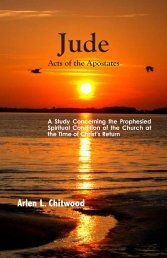Signs in John's Gospel - The Lamp Broadcast
Signs in John's Gospel - The Lamp Broadcast
Signs in John's Gospel - The Lamp Broadcast
Create successful ePaper yourself
Turn your PDF publications into a flip-book with our unique Google optimized e-Paper software.
218 SIGNS IN JOHN’S GOSPEL<br />
16:15-17, 21-23. As seen <strong>in</strong> Jesus’ statements concern<strong>in</strong>g both,<br />
there is a br<strong>in</strong>g<strong>in</strong>g forth from above <strong>in</strong> the first (vv. 15-17) and a<br />
br<strong>in</strong>g<strong>in</strong>g forth from below <strong>in</strong> the second (vv. 21-23).<br />
In the first, relative to Peter’s confession concern<strong>in</strong>g Jesus’<br />
true identity — “Thou art the Christ, the Son of the liv<strong>in</strong>g God”<br />
(v. 16) — Jesus said:<br />
“Blessed art thou, Simon Bar-jona: for flesh and blood hath not<br />
revealed it unto thee, but my Father which is <strong>in</strong> heaven” (v. 17).<br />
In the second, relative to Peter’s denial and rebuke of Christ<br />
concern<strong>in</strong>g His approach<strong>in</strong>g death, burial, and resurrection — “Be<br />
it far from thee, Lord: this shall not be unto thee” (v. 22) — Jesus<br />
said:<br />
“Get thee beh<strong>in</strong>d me, Satan: thou art an offence unto me: for thou<br />
savourest not the th<strong>in</strong>gs that be of God, but those that be of men” (v. 23).<br />
In this respect, there are only two places <strong>in</strong> which man can<br />
conduct and govern his affairs — from above or from below — <strong>in</strong><br />
l<strong>in</strong>e with the thought that a person is either for Christ or aga<strong>in</strong>st<br />
Christ (Matt. 12:30; Luke 11:23). <strong>The</strong>re is no middle ground <strong>in</strong> either<br />
<strong>in</strong>stance (cf. I Cor. 15:45-50).<br />
As previously shown, be<strong>in</strong>g brought forth from God, from<br />
above, <strong>in</strong> John’s gospel, his first epistle, James, and I Peter has to<br />
do with Christians alone. This though is not to say that man is<br />
saved through a means other than a br<strong>in</strong>g<strong>in</strong>g forth from above,<br />
for unsaved man cannot be saved through any other means.<br />
Rather, it is to say that references to a br<strong>in</strong>g<strong>in</strong>g forth from above<br />
<strong>in</strong> all four of these New Testament books (referenced sixteen times<br />
<strong>in</strong> twelve verses) do not refer to salvation by grace, the past aspect of<br />
salvation. Instead, without exception, all of them have to do with<br />
present and future aspects of salvation, the salvation of the soul (life),<br />
with ramifications hav<strong>in</strong>g to do with the Messianic Era.<br />
That seen <strong>in</strong> relation to the Jews <strong>in</strong> John 20:31 (concern<strong>in</strong>g<br />
the previously referenced signs) is exactly the same th<strong>in</strong>g seen<br />
relative to Christians <strong>in</strong> I John 5:1-5 (apart from signs).<br />
<strong>The</strong>re is a br<strong>in</strong>g<strong>in</strong>g forth from God, from above, <strong>in</strong> both



